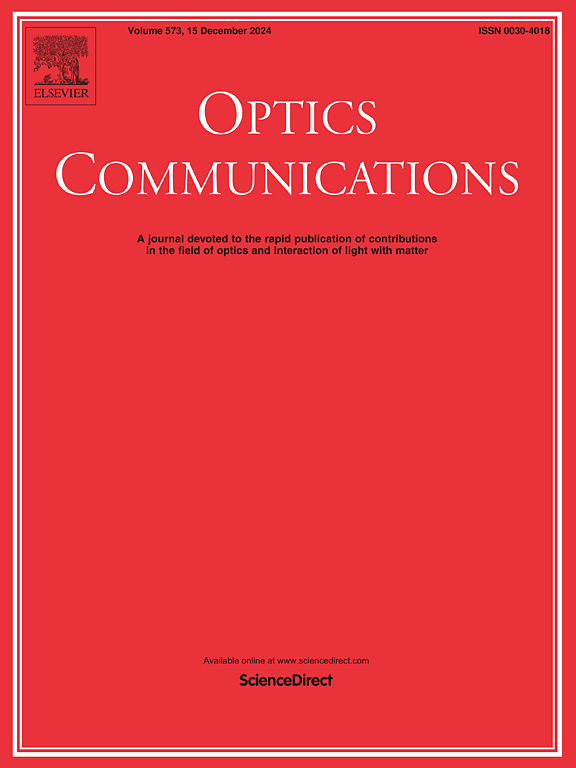Performance evaluation of large-aperture highly reflective mirrors for high-power laser applications with reflectance mapping
IF 2.2
3区 物理与天体物理
Q2 OPTICS
引用次数: 0
Abstract
The performance evaluation of large-aperture highly reflective (HR) mirrors, which are widely used in high-power laser systems, is essential for the long-term operation of these laser systems. In this study, the development of the HR mirror's reflectance distribution, which is measured via cavity ring-down (CRD) technique, to be a general quality control tool for the large-aperture HR mirrors is attempted. Various parameters and data analysis methods are defined and developed to evaluate the performance of the large-aperture HR mirrors. Specifically, we introduced the maximum-probability reflectance (Rmax-p), which describes the reflectance distribution excluding the influence of defects, and the maximum-residual-probability reflectance (Rmax-r-p), which characterizes the reflectance distribution affected by defects. Additionally, we discussed the full-width at half-maximum (FWHM) of the residual reflectance distribution, which quantifies the variation in reflectance due to defects, as well as the reflectance difference (ΔR) defined as the difference between Rmax-p and Rmax-r-p. These parameters collectively provide a comprehensive assessment of the HR mirrors' performance. The developed parameters and data analysis methods were applied to the performance evaluation of 68 HR mirrors with diameters ranging from 200 mm to 400 mm, with 0- or 45-degree angle of incidence (AOI) and fused silica or sapphire substrates. Statistical analysis revealed that HR mirrors with a 0-degree AOI have higher reflectance than that with a 45-degree AOI, while HR mirrors deposited on fused silica substrates showed slightly better reflection performance than that deposited on sapphire substrates. The statistical results demonstrated that the proposed parameters and data analysis methods are helpful to evaluate the performance of large-aperture HR mirrors.
基于反射率映射的大功率激光大口径高反射镜性能评价
大口径高反射镜广泛应用于大功率激光系统中,其性能评价对大功率激光系统的长期运行至关重要。本研究尝试开发利用空腔衰荡(CRD)技术测量的HR反射镜反射率分布,作为大口径HR反射镜的通用质量控制工具。定义和发展了各种参数和数据分析方法来评估大口径HR反射镜的性能。具体来说,我们引入了最大概率反射率(Rmax-p)和最大残差概率反射率(Rmax-r-p), Rmax-r-p描述了不受缺陷影响的反射率分布。此外,我们还讨论了残余反射率分布的半极大值全宽度(FWHM),它量化了由于缺陷引起的反射率变化,以及反射率差(ΔR),定义为Rmax-p和Rmax-r-p之间的差。这些参数共同提供了对人力资源镜像性能的全面评估。将所建立的参数和数据分析方法应用于68块直径为200 mm ~ 400 mm、0或45度入射角(AOI)、熔融石英或蓝宝石衬底的HR反射镜的性能评估。统计分析表明,AOI为0度的HR反射镜的反射率高于AOI为45度的HR反射镜,而沉积在熔融石英衬底上的HR反射镜的反射性能略好于沉积在蓝宝石衬底上的HR反射镜。统计结果表明,所提出的参数和数据分析方法有助于评价大口径HR反射镜的性能。
本文章由计算机程序翻译,如有差异,请以英文原文为准。
求助全文
约1分钟内获得全文
求助全文
来源期刊

Optics Communications
物理-光学
CiteScore
5.10
自引率
8.30%
发文量
681
审稿时长
38 days
期刊介绍:
Optics Communications invites original and timely contributions containing new results in various fields of optics and photonics. The journal considers theoretical and experimental research in areas ranging from the fundamental properties of light to technological applications. Topics covered include classical and quantum optics, optical physics and light-matter interactions, lasers, imaging, guided-wave optics and optical information processing. Manuscripts should offer clear evidence of novelty and significance. Papers concentrating on mathematical and computational issues, with limited connection to optics, are not suitable for publication in the Journal. Similarly, small technical advances, or papers concerned only with engineering applications or issues of materials science fall outside the journal scope.
 求助内容:
求助内容: 应助结果提醒方式:
应助结果提醒方式:


